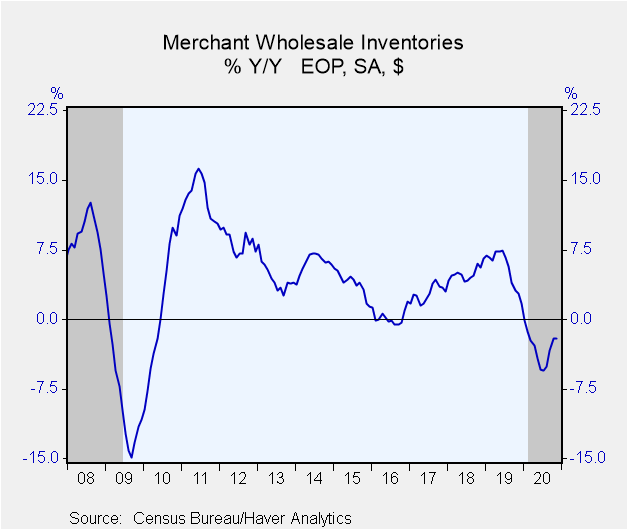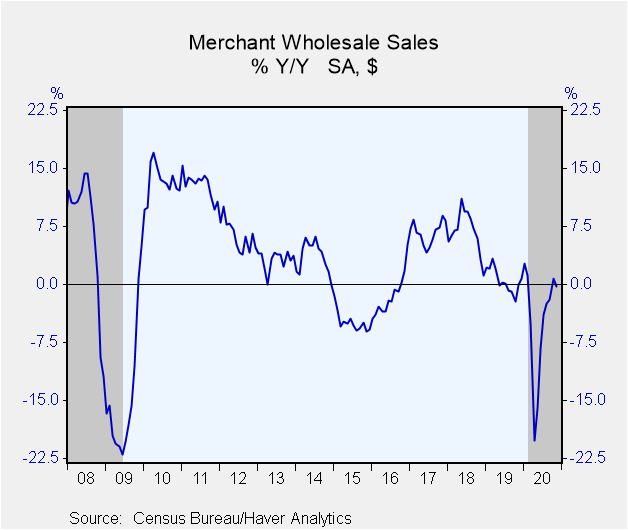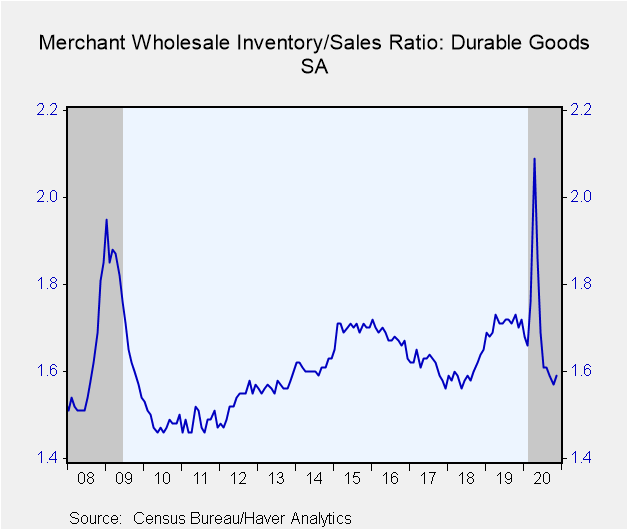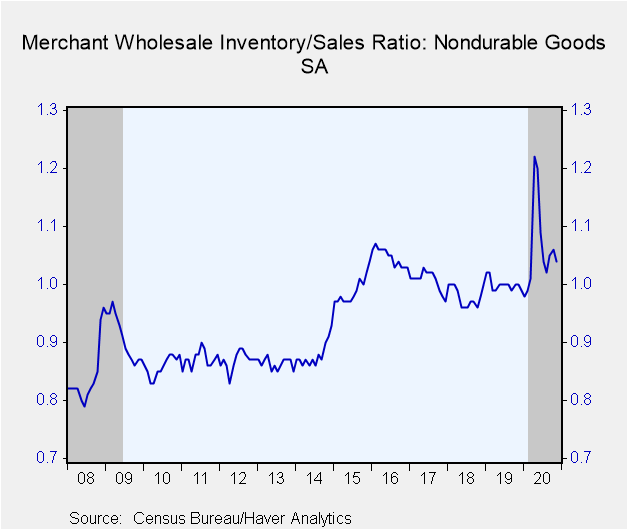 Global| Jan 08 2021
Global| Jan 08 2021Wholesale Inventories Unchanged in November; Sales Edged Up
by:Sandy Batten
|in:Economy in Brief
Summary
• Inventories unchanged while sales rose 0.2% in November. • Wholesale inventory-to-sales ratio unchanged at 1.31. Wholesale inventories were unchanged in November (-2.1% y/y) after solid gains of 1.3% m/m in October and 0.9% m/m in [...]
• Inventories unchanged while sales rose 0.2% in November.
• Wholesale inventory-to-sales ratio unchanged at 1.31.
Wholesale inventories were unchanged in November (-2.1% y/y) after solid gains of 1.3% m/m in October and 0.9% m/m in September. Inventory swings can have a meaningful impact on GDP growth. In the latest GDP report, total inventory building contributed 6.6%-points to the 33.4% q/q saar growth in total GDP in Q3 2020. Even with the unchanged reading in November, inventories are on track to add further to GDP growth in Q4.
Durable goods inventories rose 0.9% m/m (-4.1% y/y) in November with widespread gains across the major components. Gains in furniture inventories (+4.3% m/m) and computer equipment inventories (+4.0% m/m) led the overall rise. The only major component experiencing a decline in November was inventories of electrical and electronic goods (-0.8% m/m). By contrast, inventories of nondurable goods slumped 1.2% m/m (+1.1% y/y) in November following four consecutive monthly increases. Monthly declines were widespread, led by a 5.4% m/m drop in drug inventories. Petroleum and petroleum inventories jumped up 6.8% m/m following three consecutive monthly declines.
Wholesale sales jumped edged up 0.2% m/m (-0.2% y/y) in November following a downwardly revised 1.7% m/m gain in October (initially +1.8% m/m). This was the seventh consecutive monthly rise in sales after they had collapsed in March and April. The Action Economics Forecast Survey anticipated a 0.6% m/m rise. Sales of durable goods fell 0.4% m/m (+2.5% y/y), led by a 3.9% m/m decline in motor vehicle sales and a 2.6% m/m drop in furniture sales. By contrast, sales of nondurable goods increased 0.7% m/m (-2.8% y/y) in November, led by a 6.6% m/m jump in apparel sales and a 6.1% m/m increase in sales of farm product raw materials.
The inventory-to-sales (I/S) ratio at the wholesale level was unchanged at 1.31 in November. After hitting a record high of 1.63 in April (series begins in 1980), it has returned to pre-COVID levels. The durable goods I/S ratio increased to 1.59 from 1.57, which was the lowest in over two years. Meanwhile, the nondurable I/S ratio slipped to 1.04 from 1.06, down meaningfully from April's 1.22 record.
The wholesale trade figures are available in Haver's USECON database. Expectations for sales are in the AS1REPNA database.
| Wholesale Sector - NAICS Classification (%) | Nov | Oct | Sep | Nov Y/Y | 2019 | 2018 | 2017 |
|---|---|---|---|---|---|---|---|
| Inventories | 0.0 | 1.3 | 0.9 | -2.1 | 1.7 | 6.5 | 3.0 |
| Sales | 0.2 | 1.7 | 0.4 | -0.2 | 0.6 | 6.8 | 6.7 |
| I/S Ratio | 1.31 | 1.31 | 1.32 | 1.33 (Nov '19) | 1.34 | 1.28 | 1.30 |
Sandy Batten
AuthorMore in Author Profile »Sandy Batten has more than 30 years of experience analyzing industrial economies and financial markets and a wide range of experience across the financial services sector, government, and academia. Before joining Haver Analytics, Sandy was a Vice President and Senior Economist at Citibank; Senior Credit Market Analyst at CDC Investment Management, Managing Director at Bear Stearns, and Executive Director at JPMorgan. In 2008, Sandy was named the most accurate US forecaster by the National Association for Business Economics. He is a member of the New York Forecasters Club, NABE, and the American Economic Association. Prior to his time in the financial services sector, Sandy was a Research Officer at the Federal Reserve Bank of St. Louis, Senior Staff Economist on the President’s Council of Economic Advisors, Deputy Assistant Secretary for Economic Policy at the US Treasury, and Economist at the International Monetary Fund. Sandy has taught economics at St. Louis University, Denison University, and Muskingun College. He has published numerous peer-reviewed articles in a wide range of academic publications. He has a B.A. in economics from the University of Richmond and a M.A. and Ph.D. in economics from The Ohio State University.










